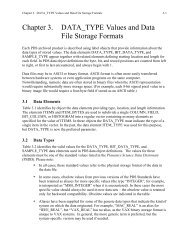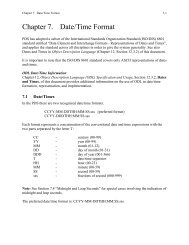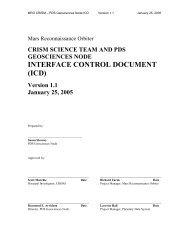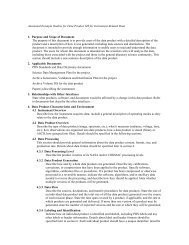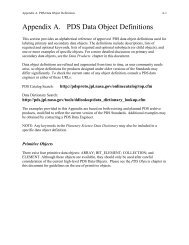Appendix C. Internal Representation of Data Types
Appendix C. Internal Representation of Data Types
Appendix C. Internal Representation of Data Types
You also want an ePaper? Increase the reach of your titles
YUMPU automatically turns print PDFs into web optimized ePapers that Google loves.
C-14 <strong>Appendix</strong> C. <strong>Internal</strong> <strong>Representation</strong> <strong>of</strong> <strong>Data</strong> <strong>Types</strong><br />
C.7 PC_REAL<br />
Aliases: None<br />
This section describes the internal storage format corresponding to the PC_REAL data type. In<br />
this section the following definitions apply:<br />
b0 – b9<br />
m-sign<br />
int-bit<br />
e0 – e1<br />
Arrangement <strong>of</strong> bytes as they appear when read from a file (e.g., read b0<br />
first, then b1, b2 and b3)<br />
Mantissa sign bit<br />
In 10-byte real format only, the integer part <strong>of</strong> the mantissa, assumed to be<br />
“1” in other formats, is explicitly indicated by this bit.<br />
Arrangement <strong>of</strong> the portions <strong>of</strong> the bytes that make up the exponent, from<br />
lowest order to highest order. The bits within each byte are interpreted<br />
from right to left (e.g., lowest value = rightmost bit in the exponent part <strong>of</strong><br />
the byte, highest value = leftmost bit in the exponent part <strong>of</strong> the byte) in<br />
the following way:<br />
10-bytes (temporary):<br />
In e0, bits 0-7 represent 2**0 through 2**7<br />
In e1, bits 0-6 represent 2**8 through 2**14<br />
Exponent bias = 16383<br />
8-bytes (double precision):<br />
In e0, bits 4-7 represent 2**0 through 2**3<br />
In e1, bits 0-6 represent 2**4 through 2**10<br />
Exponent bias = 1023<br />
4-bytes (single precision):<br />
In e0, bit 7 represent 2**0<br />
In e1, bits 0-6 represent 2**1 through 2**7<br />
Exponent bias = 127<br />
m0 – m7<br />
Arrangement <strong>of</strong> the portions <strong>of</strong> the bytes that make up the mantissa, from<br />
highest order fractions to the lowest order fraction. The order <strong>of</strong> the bits<br />
within each byte progresses from left to right, with each bit representing a<br />
fractional power <strong>of</strong> two, in the following way:<br />
10-bytes (temporary):



